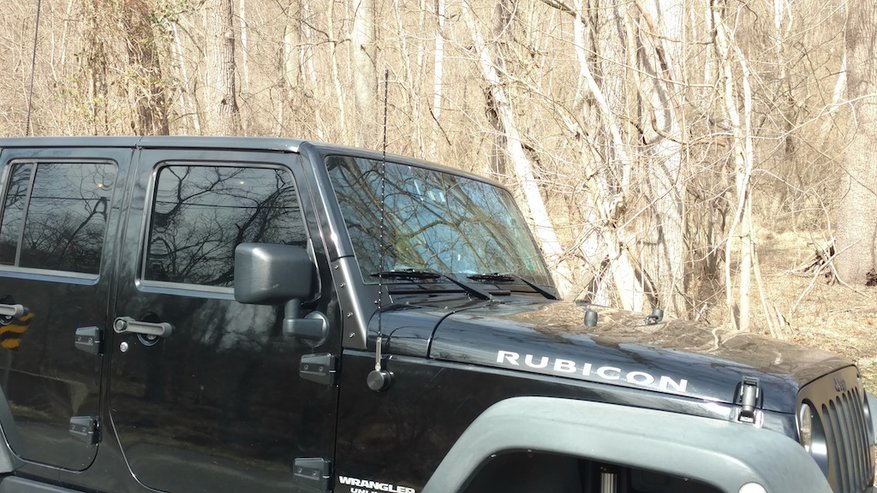by Scott Ammerman
Quadratec Channel Correspondent
One of the more inconvenient detriments to clearance on the exterior of the JK Wrangler is the factory AM/FM radio antenna. It sticks up fairly high above the roofline, and manages to get caught on branches hanging over the trail quite regularly. It is possible, as I have recently noticed, to bend it to the point it will snap back and hit the windshield frame metal, as well as the body right above the antenna base. I’ve also had to bend it back to straight twice in as many months. Discoloration from rust has started to set in, so replacing the antenna quickly made its way to the short list for spring upgrades.
The reason for factory antennas to be as long as they are is to maximize performance, but this really isn’t the best solution for knocking around in the woods. Stubby (or stubbie, depending on the manufacturer) antennas are one solution to this problem, but the can come with the cost of severely limiting your radio reception. These products are usually made of stainless steel rod stock, or a flexible rubber compound that can bend with wind resistance - leaving a permanent curvature to the mast over time. I’ve also never really liked the way the latter choice looks, since they remind me of the 'rubber ducky' replacement antennas on 1980s cordless phones. If radio reception is important to you, these simply aren’t the best choice.
Quadratec offers another option, the ISCONNECT CB Style Antenna. This custom-engineered solution is available in two styles, and installs in just a few minutes. The version I’m using for this installation features a quick disconnect on the base of the antenna - it can be removed in seconds for trail days, car cover installation, or automatic car washes that might damage a factory antenna. It is also spiral-wrapped to reduce wind noise, and is very similar in appearance to black flexible mast CB antennas.
Since this item is copper coil wound internally, it retains the same excellent reception qualities that the factory antenna offers, while limiting the drawbacks substantially. The antenna mast itself is made of fiberglass, to allow for extreme flexibility as well as strength. This kit is made exclusively for Quadratec, right here in the USA. With the quick disconnect, the antenna’s length is almost exactly the same as factory.
Required tools:
- 7/16” wrench for antenna mast (or a small adjustable if you don’t own SAE wrenches)
- 10mm wrench for removing factory antenna
- 16mm wrench to attach antenna adaptor
- 13mm wrench to tighten the quick release (if you want to install the same version I did)
Installation:
This is actually a very simple procedure. The only reason I’m going over the steps is to show you how easy this installation really is, and to illustrate the thought that went into this design. In fact, it took me far longer to write this how-to than it did to install.
There are only four components we’re working with: the antenna mast, the antenna adaptor, the machined PVC bezel, and the quick release assembly (optional).
Start by removing your factory antenna mast with the 10mm wrench.

Tighten the antenna adaptor to the bottom of the quick release using 16mm and 13mm wrenches.

Put the PVC bezel over the factory antenna base, and thread the antenna adaptor and quick release into the factory base by hand.

Use the 16mm wrench again to tighten the adaptor to the factory base until it fits snugly.

Hand tighten the quick release top to the antenna mast, and install it by pushing down onto the base against the spring, and giving it a quarter turn to lock. Use your 13mm and 7/16” wrench to fully tighten the antenna mast into the quick release.

To remove the mast with the quick release, simply grab the collar and push down with a quarter turn, and the entire assembly comes right off.
Now, a note on reception:
Since I have no ‘scientific’ way to measure reception, the best I could do to determine performance was tune in two weaker stations, on both AM and FM, and see what effect the new antenna had on signal quality.
While stationary, FM reception was nearly identical - but the AM reception with the new antenna was actually slightly crisper. While on the road during my normal commute, I received solid signal quality on all the same stations I normally do without issue, but the AM radio dead spots I normally experience weren’t quite as bad.
Again, the main selling point for me was that ability to quickly pull off the antenna when I don’t need it. The added reception over the factory setup was a bonus. Plus, since all its metal components are made of stainless steel, they’ll look great for years to come.
I’m definitely looking forward to my next Rausch Creek trip, and not having to hear that twang of the metal antenna whacking branches all day long.





















